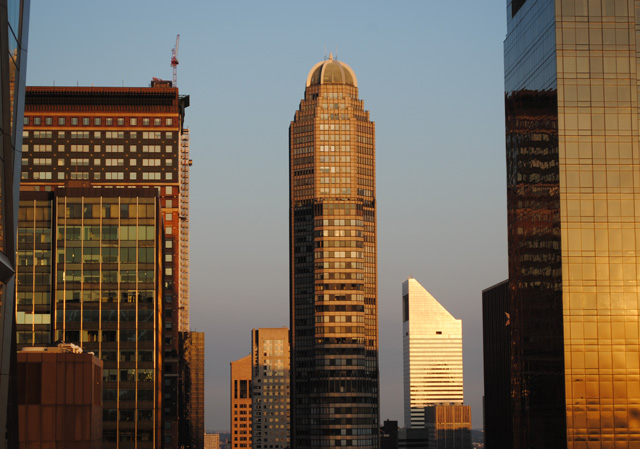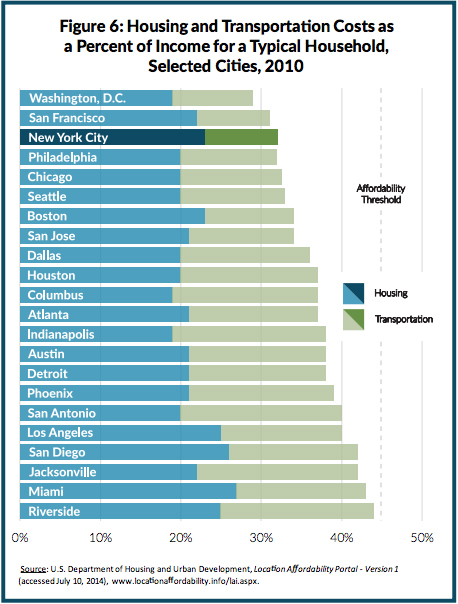Earlier this month, the Citizens Budget Commission released another policy brief in their series on affordability in New York City, this time with a focus on housing and transportation costs. And they came to a startling conclusion: New York City (or, more accurately, the greater New York region) is the third most affordable big city in the nation.
The report finds that the average renting household in the region earns $63,915 each year, and shells out $14,700 for housing and $5,752 for transportation.
“Housing and transportation costs for the typical household are 32 percent of income in New York City, with lower ratios only in Washington, D.C. (29 percent) and San Francisco (31 percent),” the report claims.
But as you write your landlord a check for September’s rent, you might find yourself puzzling over this conclusion. While the ability of many households to get by without a car surely does blunt some of the blow of New York’s housing costs, the finding does not accord with the reality faced by many New Yorkers, and does not absolve the city and region of finding ways to lower the cost of housing.
The first thing to keep in mind is that because of the region’s high proportion of non-market housing, the average annual rent – $14,700 – is, for the most part, not actually available to those not already paying that.
In New York City, which houses around 40 percent of the region’s population and an even higher proportion of its renters, just over 60 percent of the rental units fall under some sort of below-market program, according to a 2011 analysis. Most of these were rent-stabilized, with others being rent controlled and still others existing in public housing complexes (where the average rent is less than $445 a month). In 2008, another CBC report found that rent regulation reduced the price of an apartment by, on average, $458 a month from their market-rate counterparts.
New York State’s rent regulation also covers some units in Nassau, Westchester and Rockland counties, while many of New Jersey’s urban cities also have rent regulation programs, as well as a number of public housing authorities.
As with any below-market housing program, the number of units demanded at the prices they’re being offered outnumbers the quantity supplied, often by a depressingly wide margin. The New York City Housing Authority has a quarter of a million families on its waiting list (more than the number of units it controls), with another 100,000 exclusively on the waiting list for Section 8 housing vouchers. And with a 124-unit affordable housing building in Harlem attracting 50,000 applicants, the term “housing lottery” is barely an exaggeration of the odds of winning the right to rent in a new below-market building.
So while the average regional renting household may pay $14,700, that price is likely not available to someone searching for a new home. This applies most obviously to newcomers, but also to any native New Yorker looking to change addresses, whether because of a divorce, a new job in a different part of the region, or simply because they turned 18 and don’t want to live with their parents forever.
Another caveat to the report is that it measures affordability as a proportion of income. While this makes sense to some extent – wages for the same job are likely higher in New York City than they are in Houston or Atlanta – incomes within a given area are not totally independent of housing costs.
When the price of housing is high, it will presumably push low-wage earners out, making the region seem more affordable than it is by a proportional metric. By the same token, these standards artificially punish cities like Miami and Houston, which are attractive places for poor immigrants because they allow lots of housing production, and as a result, have low rents.
Making commuting from far-flung neighborhoods and suburbs easier is one way to partially compensate for high housing costs, and New York’s extensive legacy rail networks – it’s the only city in the world to have a comprehensive system of express subway trains, for example – accomplishes this to some extent.
But we’re running on fumes. We’ve fallen desperately behind on transit construction and upgrades and have very poor access to the suburbs compared to peer cities like London, Tokyo and Paris. Those cities started upgrading their commuter rail lines to be more like subways decades ago, with frequent off-peak service, minimal on-board staffing, and lower ticket prices, with various levels of fare integration with the subway and surface transit networks. Paris is even planning a network of driverless subways for its suburbs, to mitigate the impact of its anemic housing production numbers — about on par with New York’s — and resulting high housing costs.
New York’s politicians, on the other hand, appear incapable of conceiving of a suburban railway that isn’t packed with costly conductors and doesn’t charge $7 for a one-way fare on an off-peak train that only comes once or twice an hour. And with transit construction costs that are many times those in other first-world cities, full-blown subways or elevated lines to the suburbs are a non-starter, despite New York’s generous capital funding for transit.
As for buses, a few of them are getting “SBS” branding and upgrades, but the MTA appears to be in no hurry to roll out improvements like proof-of-payment ticketing across the system, as is common in Europe.
If New York is going to be a welcoming place for newcomers and its own natives, it must tackle its high housing costs. Rent stabilization for those lucky enough to already have affordable apartments — and an extensive in-city transit network left over from the first half of the 20th century that does not meet the needs of the 22-million person greater metropolitan area — clearly show that political will and macro-scale changes are needed if the current crisis is to end. And besides occasional banter about affordable, lottery-drawn apartments, reform is not on the horizon.
Talk about this topic on the YIMBY Forums
For any questions, comments, or feedback, email newyorkyimby@gmail.com
Subscribe to YIMBY’s daily e-mail
Follow YIMBYgram for real-time photo updates
Like YIMBY on Facebook
Follow YIMBY’s Twitter for the latest in YIMBYnews


